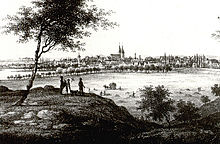Mägdesprung (Calbe)
The Mägdesprung is a hill in Calbe (Saale) in the salt district of the state of Saxony-Anhalt .
The existence of the Mägdesprung in the north of the city as well as that of the Wunderburg in the south of the city has been known for several centuries . Both are still present as field names today . Maiden jumps are known in Germany, so in the Harz and on the island of Rügen .
Landscape monument
The Mägdesprung in Calbe is a hill at the northern end of the current “green lung”. In many German places and landscapes there are names such as Mädchensteine, Jungfernsteine, Mädchenprung, Mägdesprung, Mädelsteg, Mädchenburg or Mädchenlucken (caves). Such places could be early fertility and women's cult sites .
Mention in the sources
The Mägdesprung von Calbe was first mentioned as a field name in 1446 when Archbishop Friedrich III. some people with a "width" (field width) under the "Meigdesprunge before Calbe" enfeoffed. In 1555 and 1566, Hans von Bockwitz had a meadow “under the Mesesprunge”, which denotes the same place, as a fief. “Messesprung” could be an older, vulgarizing form of Mägdesprung.
Attempts at interpretation
The regional historian Adolf Reccius saw the Mägdesprung in Calbe as an ancient women's dance floor. At the women's or maid jumps, sacrifices for a female fertility cult and rites to introduce young girls into the world of women took place. Reccius did not rule out the possibility that it was a “maidservant jump ”, that is, a source. However, analogies to other Maiden's leaps make the first guess appear more likely.
Execution at Mägdesprung
The place of execution by Calbe , which was used from the Middle Ages to the beginning of the 18th century, was ostentatiously placed directly at the Mägdesprung. Witch burnings took place here until 1688 .
Calber Mägdesprung legend
As with other Mägdesprüngen, an explanatory legend with an analogous subject was created in Calbe . It is reproduced for the first time in a chronicle of the monastery "Gottes Gnade" from the 18th century, whereby the author refers to another church chronicler named Reinhold Bakius from the 17th century:
A count once kidnapped a royal bride. When he was pursued by the royal rulers, “if he had sat down with her by the Vorwerck Gritzehne through the hall and promised God that if he would get through the water happy with the treasure he had with him, he would have wanted a monastery before the grace of God if he later directed it to Werck, and would have named God's grace. ”The fact that in this case a count plays the main role could be the expression of a collective memory of the actual founder of“ God's grace ”, Count Otto von Reveningen and Krottorf , be.
Excursion destination
In the 19th century, when the urban bourgeoisie withdrew to Biedermeier idylls in times of political oppression and developed an intense love for nature, the elevated views in front of Calbe, in the south the wonder castle and vineyard area on the high bank of the Saale and the Mägdesprung became popular Excursion destinations. The “Felsenkeller zum Mägdesprung” built at that time was a popular restaurant until the first half of the 20th century.
swell
- Johann Georg Leuckfeld: Antiquitates Praemonstratenses or historical message from two formerly famous Praemonstratensian monasteries S. Marien in Magdeburg and God's grace at Calbe . Seidel, Magdeburg / Leipzig 1721.
- Adolf Reccius: Chronicle of the homeland (documented news about the history of the district town of Calbe and its immediate surroundings) . Goppel, Calbe / Saale 1936.
Coordinates: 51 ° 55 ′ 0.3 ″ N , 11 ° 47 ′ 48.8 ″ E

